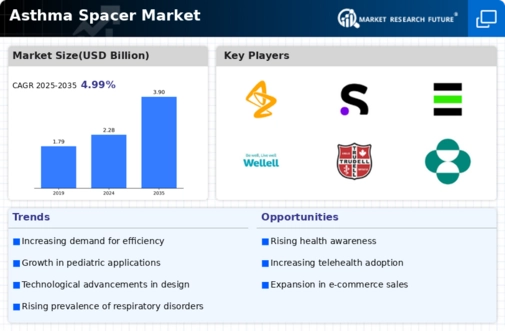Market Growth Projections
The Global Asthma Spacer Market Industry is projected to experience substantial growth over the next decade. With a market value of 2.28 USD Billion in 2024, it is expected to reach 3.9 USD Billion by 2035, reflecting a CAGR of 4.99% from 2025 to 2035. This growth trajectory indicates a robust demand for asthma spacers, driven by factors such as increasing asthma prevalence, technological advancements, and heightened awareness of asthma management. The market's expansion is likely to create opportunities for manufacturers and healthcare providers to innovate and improve asthma care solutions.
Rising Prevalence of Asthma
The increasing prevalence of asthma globally is a primary driver of the Global Asthma Spacer Market Industry. According to health statistics, asthma affects approximately 300 million individuals worldwide, with a notable rise in cases reported in urban areas. This surge in asthma cases necessitates effective management solutions, such as spacers, which enhance the delivery of medication. As awareness of asthma management grows, the demand for spacers is expected to rise, contributing to the market's projected growth from 2.28 USD Billion in 2024 to an estimated 3.9 USD Billion by 2035, reflecting a compound annual growth rate (CAGR) of 4.99% from 2025 to 2035.
Government Initiatives and Support
Government initiatives aimed at improving respiratory health significantly influence the Global Asthma Spacer Market Industry. Many countries have implemented programs to promote asthma awareness and management, which often include the distribution of spacers as part of treatment plans. For example, public health campaigns in various regions encourage the use of spacers to ensure proper inhaler technique, thereby improving medication delivery. These initiatives not only enhance patient outcomes but also stimulate market growth by increasing the accessibility of spacers. As governments continue to prioritize respiratory health, the market is expected to benefit from increased funding and resources.
Increase in Healthcare Expenditure
The upward trend in healthcare expenditure globally is a significant factor propelling the Global Asthma Spacer Market Industry. As countries allocate more resources to healthcare, there is a corresponding increase in spending on respiratory treatments, including asthma management products like spacers. This trend is particularly evident in developed nations, where healthcare budgets are expanding to accommodate advanced medical technologies and patient care solutions. The increased investment in healthcare not only enhances the availability of asthma management products but also supports research and development efforts, further driving market growth.
Growing Awareness of Asthma Management
The rising awareness regarding asthma management is a vital driver for the Global Asthma Spacer Market Industry. Educational programs and campaigns aimed at patients and healthcare providers emphasize the importance of proper inhaler techniques and the role of spacers in effective medication delivery. This heightened awareness leads to increased adoption of spacers among patients, as they recognize the benefits of using these devices for better asthma control. As more individuals become informed about asthma management strategies, the demand for spacers is likely to grow, contributing to the market's expansion in the coming years.
Technological Advancements in Spacer Design
Innovations in spacer technology play a crucial role in shaping the Global Asthma Spacer Market Industry. Recent advancements have led to the development of spacers that are more user-friendly, portable, and effective in delivering medication. For instance, the introduction of smart spacers equipped with sensors allows for real-time monitoring of medication usage, enhancing patient adherence. Such technological improvements not only improve treatment outcomes but also attract more consumers to the market. As these innovations continue to evolve, they are likely to drive market growth, aligning with the increasing demand for efficient asthma management solutions.





















